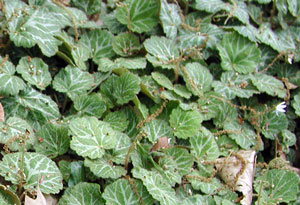Resource Library
Plant of the Week: Strawberry Geranium
The University of Arkansas System Division of Agriculture does not promote, support or recommend plants featured in "Plant of the Week." Please consult your local Extension office for plants suitable for your region.
Plant of the Week
Strawberry Geranium
Latin: Saxifraga stolonifera

By definition, any plant you may not know will be new to you on first meeting. Gardeners are always enamored by all things new, but the headlong rush to newness often overlooks other interesting plants that have been around for a long time. So let’s consider the strawberry geranium, Saxifraga stolonifera.
Strawberry geranium, also known as creeping saxifrage, creeping rockfoil or Aaron’s beard, is an herbaceous evergreen groundcover that grows only 3 to 4 inches tall with the plant growing in a tight rosette of leaves. In the spring, the central rosette sends out a number of foot-long slender, strawberry-like maroon stolons that form a plantlet at the tip where it comes in contact with the soil.
The pubescent leaves are round, spoon-shaped affairs to 2 inches across on an equally long petiole. New leaves in the spring will be blue-green in color, featuring veins marked with a distinctive silver band. The undersurface of the leaf is reddish purple. As the season wears on, the silvery marking becomes less distinctive.
In spring, a slender, floppy foot-tall inflorescence is produced that bears a number of dime-sized white flowers with five distinct petals, the two lower of which are distinctly larger than the upper petals. The flowers are a nice bonus, but the foliage is the main ornamental feature. If seed is produced it is rare; spread seems to be exclusively by means of the stolons.
Strawberry geranium is native to eastern Asia, the Korean peninsula and Japan, where it grows from the lowlands to about 4,000 feet in the mountains. The Latin name “Saxifrage” means “rock-breaking,” a reference to the fact that most of the 440 kinds of saxifrages grow in rocky crevices, often near the snow line at mountaintops. Most saxifrages are challenging to grow in a warm-temperate climate, but this species is the exception, being very hardy from zones 6 through 9.
Not surprisingly, this was one of the plants brought back from China in the middle of the 18th century, probably by Dutch traders. The first illustration and naming credit for the plant goes to Nicholaas Meerburgh (1734-1814), a botanist in charge of the Leiden Botanic Garden in Holland. Meerburgh was also a gifted illustrator who began publishing his Illustrations of Rare Plants in 1775. The folio-size plates were released in sets of 10 over several years. Through the magic of the Internet, this rare book – one of only three known to exist in the folio format – can be viewed online thanks to the digitizing efforts of the Missouri Botanical Garden.
Strawberry geranium is often listed as a houseplant, but if grown inside it should be kept in a cool place where it receives filtered light. Mealybugs are a serious problem when used as a houseplant. It makes an excellent, easy-to-grow groundcover plant that will slowly colonize an area. I’ve had a clump for over 10 years and it mostly lurks beneath the canopy of larger perennials and shrubs. For me it has not been at all aggressive. It prefers moderately moist situations with filtered light. In a landscape setting, the plant appears to immune to most insects.
By: Gerald Klingaman, retired
Extension Horticulturist - Ornamentals
Extension News - November 5, 2010
The University of Arkansas System Division of Agriculture does not maintain lists of retail outlets where these plants can be purchased. Please check your local nursery or other retail outlets to ask about the availability of these plants for your growing area.